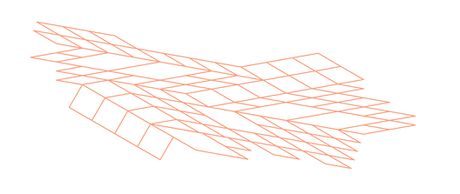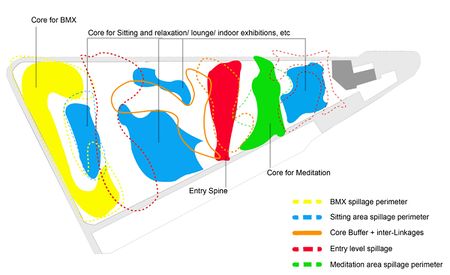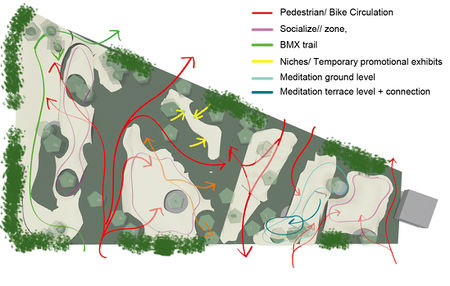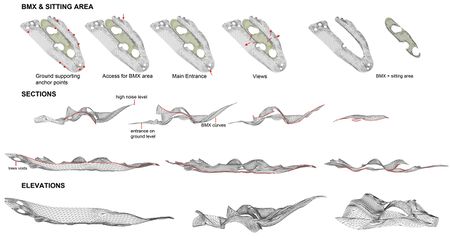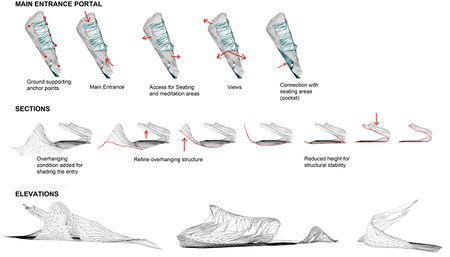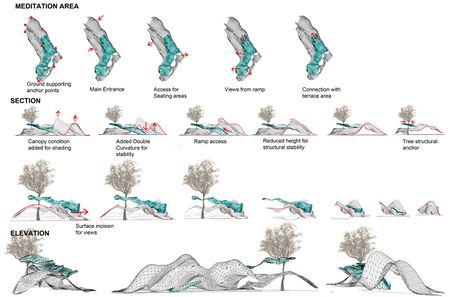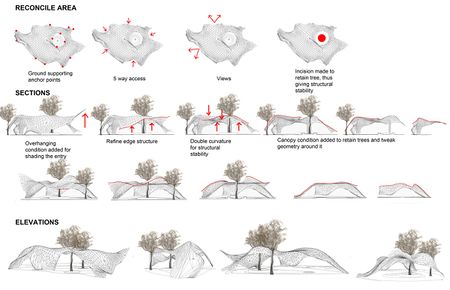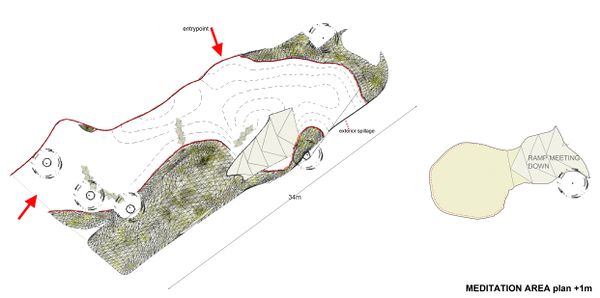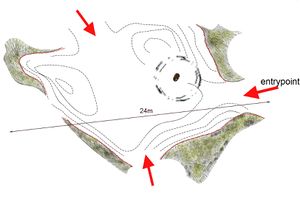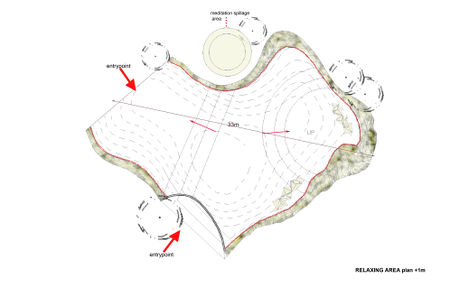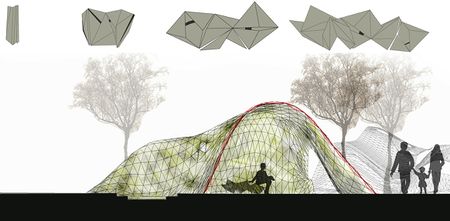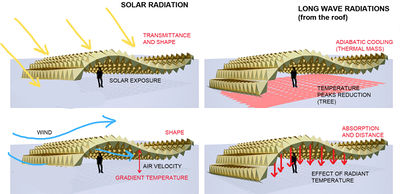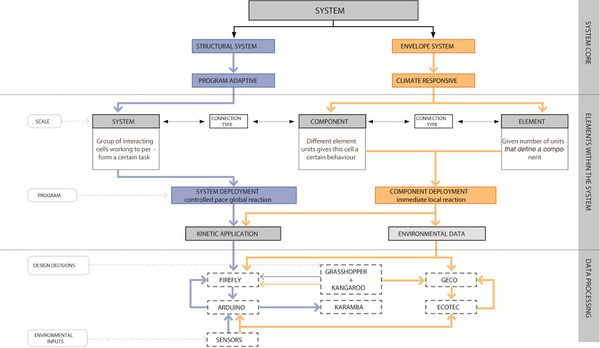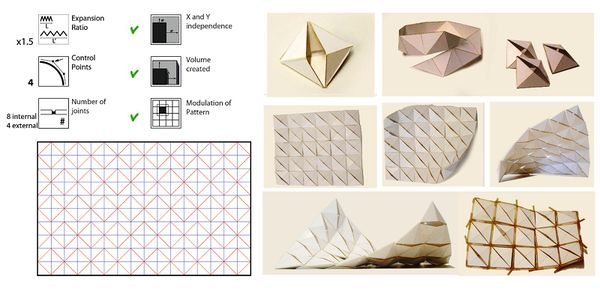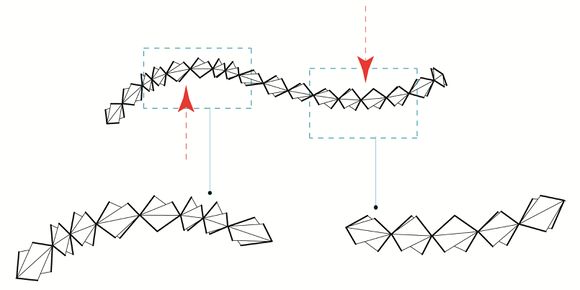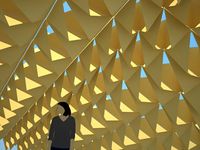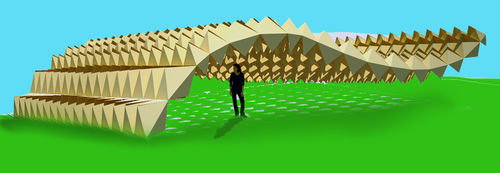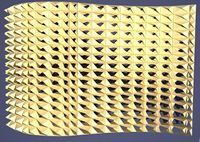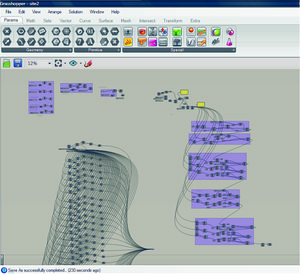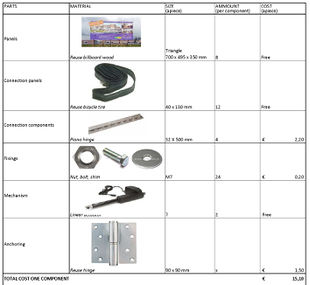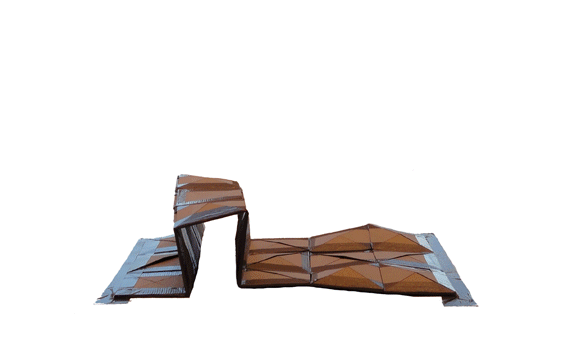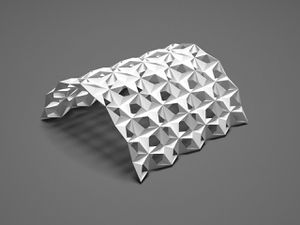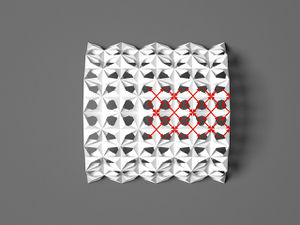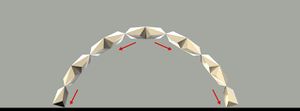project H:ARCHIVE
MULTI-COMPONENT SYSTEM RESEARCH
Our specialization is “multi component system”. We are trying to make components that can adapt (move, rotate, change color, etc.) by using real time information provided by sensors. In our specialization we search deep to find the optimal shape for these components within several conditions.
Mapping will be used as a tool to identify the patterns and understand them. It explains the found information to our validators as well.
PATTERNS AND GEOMETRY
We experiment with patterns which generally find references to the nature. A self-organization pattern as the one we will use is dynamic and gets developed over time. Based to the principles of self-similarity (the fundamental principle of a self-similar structure is the repetition of a unit pattern on different size scales), we can create a structure which theoretically can be extended to infinity and to adapt to every site.
PARAMETERS
For our project we are collecting two kinds of parameters.
To create our structure we are collecting parameters from the site and its environment. We are using the average value of the wind and sun seen over a year. Further we collect information from the existing pathway and linkages.
The parameters for our components are real time collected. We will place sensors on our components that will collect information which will be directly processed.
SPATIAL SPILLAGE
The surfology and its spatial types within the park topography afford the triggerings of activities within the programs of the park. These activities are of the temporal meaning that other activities can than be triggerd!
The surface inflections within each function are never tied to specific users or goods so they have capacity to change the organization of the activities taking place in them!
FORM PROCESS SUMMARY
It was important to track key points and different design decisions throughout the development of forming the structure. While the initial form was a rather computational response to program and site conditions, the process of arriving at a solidified form for the structure was tedious. Clear moves were made at specific points in the process to provide for program, site conditions, access, climate, views and structure .
</div>
PLANS
CLIMATIC CONTROL

INTRODUCTION
There are two branches in physics that were explored separately in this stage.
Kinematic is a branch that studies different movement of body parts in relationship to its joints without considering the external forces that are needed to activate the movement.
Kinetic is a wider branch in a sense that this branch is concerned with not only the motion of bodies but also the forces needed to cause motion. In the case of architecture, kinetic can become very complicated. Computerized software and hardware will then need to be synchronized to achieve this goal.
METHODS AND TECHNIQUES
There are different methods and techniques to develop responsive architecture. We have tried to experiment with some of these systems.
FOLDING
As a generative process, folding architecture is an experimental system. The relationship between each crease, fold, score, and cut give an infinite possibilities for form and function. Origami is the traditional Japanese form of paper art. This basic system is only using mountain folds (fold up) and valley folds (fold down). When origami changes to a larger scale, folding is no longer applicable. We then use rigid sheets and hinges. In this case, it is not required for the structure to start as a flat surface. This branch of origami is called “rigid origami” also named “Deployability”.
HYBRID SYSTEM
A Hybrid system is the integration of two or more different systems which otherwise have not been previously used within a single system. In the rest state, the material has no structural capacity, however, when in a pretension form through geometric formation the material works as a structural membrane supporting its own weight. Pre-tensioning the material changes its property and helps to store some energy which can later be used in correlation with various mechanical actuators. As a result, the exchange communication between the material, sensors and actuators creates a dynamic hybrid system with emergence behaviour.
EVALUATION AND PROPOSED METHOD
The System Branching
This diagram explains the methods and techniques that will be applied though out in order to achieve a “Responsive Kinetic System”. As previously noted, there are two different categories that will be examined. First, a Structural Responsive System capable of shape change in response to various functional needs. Second, an Environmental Responsive System that transforms based on several environmental conditions. These two categories are studied simultaneously on separate explorations. Eventually, these two systems will merge as collective behavior; performing and complimenting each other as one compound system.
MODULAR PATTERNS
Knowing the strategy within simple patterns, we move onto more complex patterns. Modular patterns are usually asymmetrical; however, the patterns consist of smaller modular components that can be repeated on the surface. Modular patterns can be deployed to form different volumes while remaining as a surface when retracted. Due to its triangularity,
twisting and deformation is not visible at this scale. Modular patterns have a smaller ratio of expansion in the X and Y axis, however, they make up for it due to their greater volumetric expansion. From experimenting with the paper model, it seems that these patterns have the potential to control expansion independently from each other’s axis.
COMPLEX PATTERNS
The second type of patterns are the complex patterns which can be considered as difficult patterns when folding due to the variety of repetition from ridges and valleys from one point its immediate neighbour through faces. Once folded, the transformation of the surface is more difficult to control and to predict.
After exploring different patterns in this category, it becomes the most interesting due to the intricacy of the surface and the volume that it creates. Starting by holding the two sides, we can expand the surface by pulling it apart and at the same time create surface curvature on the other two sides. Its very flexible and deployable in nature. The only difficulty which we came across is the connection to the adjacent components.
EVALUATION AND SELECTION
From all of these pattern explorations, we selected a pattern. Using the concept of rigid origami, paper folding is replaced by rigid surface panels and joints for greater force resistance and structural integrity. To test this, larger scale models are required.
This MODULAR pattern component was chosen due to its expendability, control points, modularity, and the ability to create volume. From our previous hypothesis, it is important to check the expansion depending on X axis and Y axis. Because this surface transforms from a surface to a volume, we can conclude that it exhibits high potential to generate architectural spaces.
Positive aspects:
1)Independent control on each direction resulting in more form possibilities.
2)To control local displacement, 2 actuators per component are needed.
3)Non-triangulated elements increase the possibility of non-planar elements.
Negative aspects:
1)Complex system connections irrespective of simple local actuation principles
2)Integration
GEOMETRIC ANALYSIS
Nine different component geometries obtained by the combination of 3 stages in the actuators: open, semi-open and closed.
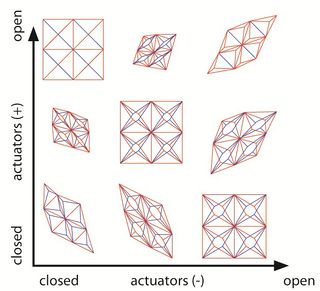
SECTIONAL ANALYSIS
Sections of the surface when activated in 2 different ways by local components reflecting curvature change in the global geometry.
KINETIC ACTUATOR AND CONTROL
In a kinetic system, there are two main ways of controlling motion; one being local control and another one being global control.
In global control, movement or displacement is defined by a single processor. As a result, several configurations and movements may be achieved. For instance, if an element is designed to move along the X, Y, and Z axis, it is more likely to do so within same formation every time it is activated. Therefore, the sequence of motion would not be adaptable to other sequences under different conditions.
On the contrary, systems with local control are most likely to have multiple processors and actuators. This means that each processor acts as a parameter that is uniquely designed and engineered to respond to one particular condition. When assembled together, different parameters will behave as one collective behaviour. This characteristic makes a system versatile and able to adapt to several different conditions.
KINETIC: SURFACE CONTROL
Through digital and physical model explorations, we are trying to prove that component becomes the most successful for independent control.
Local control - digital exploration
In order to gain local control, we begin by testing a foldable surface in terms of its components. At first, these components are studied as a two-dimensional surface which begins to change shape not only from its components but also from its own boundaries . This shape change is possible by controlling the aperture percentage from one component to the next. In return, being able to expand or contract the surface in some areas more than others. However, it is important to make note that there is always a sequence or a pattern that follows depending on which component becomes actuated before the others, and also depending on the location of this component within the surface area. In other words, there is a relationship between expanding or contracting depending on the aperture sequence from one component to the next.
DETAILS
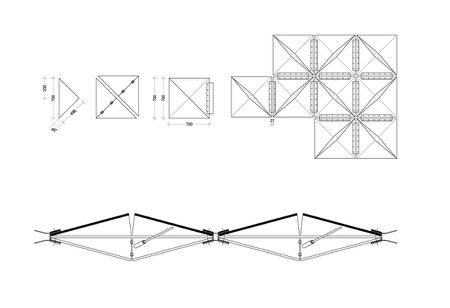 The fabricating process will start by cutting the wood into triangles. The connections between the panels of a component will be made by piano-hinges. For the connections between the components we will use bicycle tires. These tires will be bolded to the panels and glued together to form the connection and to create a hinge for the panels. Each component will have two actuators which will be attached on the inside of the component. They form a diagonal connection between the joints so that when activated both sides of the component will open.
The fabricating process will start by cutting the wood into triangles. The connections between the panels of a component will be made by piano-hinges. For the connections between the components we will use bicycle tires. These tires will be bolded to the panels and glued together to form the connection and to create a hinge for the panels. Each component will have two actuators which will be attached on the inside of the component. They form a diagonal connection between the joints so that when activated both sides of the component will open.
TIME-LINE AND MATERIALS
Many of the materials we use for fabricating the prototype are used materials. We are using bicycle tyres, wood from billboards and second hand hinges. The fixings will be made by bolts and nuts. With this we are able to connect and disconnect the components for transportation to another site.
STRUCTURE
Our load bearing structure will be created by the component itself. When a component opens it is deforming, the outlines change. What first seemed to be the biggest challenge of our component, became very useful. When the component changes its outlines it creates tension in the components surrounding it. By anchoring the outlines of the complete structure and opening the components we can create a stiff structure. By adjusting the size of the openings by the actuators we can control the shape.
RELATIONSHIPS
ATOMS
Still our atom is in his origin state no collaboration has taken place. As to the relations to other atoms, atom 3 is on the same level with their component. The research we both did is quite different, but the outcome shows similarities .
PROJECTS
Project G is making a platform that can adjust to different functions. This concept is completely different than ours but the similarities are in the components. They also have designed one component they use repeatedly. Making a complex structure out of simple components.
SURVEY
We have created a online questionnaire. With the gathered information we try to improve the communication and cooperation with our validators.
Survey: http://questionpro.com/t/AHYO7ZLxYL
VALIDATORS
STUDENTS BK: Wouter Kroon, Ifigenia Dimitrakou, Vladimir Ondejcik , Terry Pater
RESIDENTS STUDENT DWELLING: Ramon Rodrigo
ARCHITECTS: Spiros Papadimitriou (Spiros ip architecture,Thessaloniki)
PROFESSIONALS: Ben Bisseling
CONSULTANTS
FABRICATION + SUSTAINABILITY: Neelabh Gupta (M.Sc.SET)
MATERIAL SCIENCES: Getting in touch with material manufacturers, in which we are interested in.
TECHNICAL SCIENCES: TNO is an independent research organisation whose expertise and research make an important contribution to the competitiveness of companies and organisations, to the economy and to the quality of society as a whole.
INTERACTIVE SCIENCES: Studio Roosegaarde creates interactive artworks that explore the dynamic relation between space, people, and technology. As laboratory for interactive projects, the studio develops its own technology and design and is internationally known for interactive artworks such as Dune and Sustainable Dance Floor.
Print media
Fabrication - the designer's guide From
Media House Project (IAAC)
Form Defining Strategies
Making Things Move
From Control to Design:Parametric/Algorithmic Architecture
Pamphlet Architecture 27: Tooling
Online media
http://www.studioroosegaarde.net
generative- forums-links
Generator X http://www.generatorx.no/
Tropolism http://www.tropolism.com/
SuckerPunch http://www.suckerpunchdaily.com/
Office dA http://www.officeda.com/

